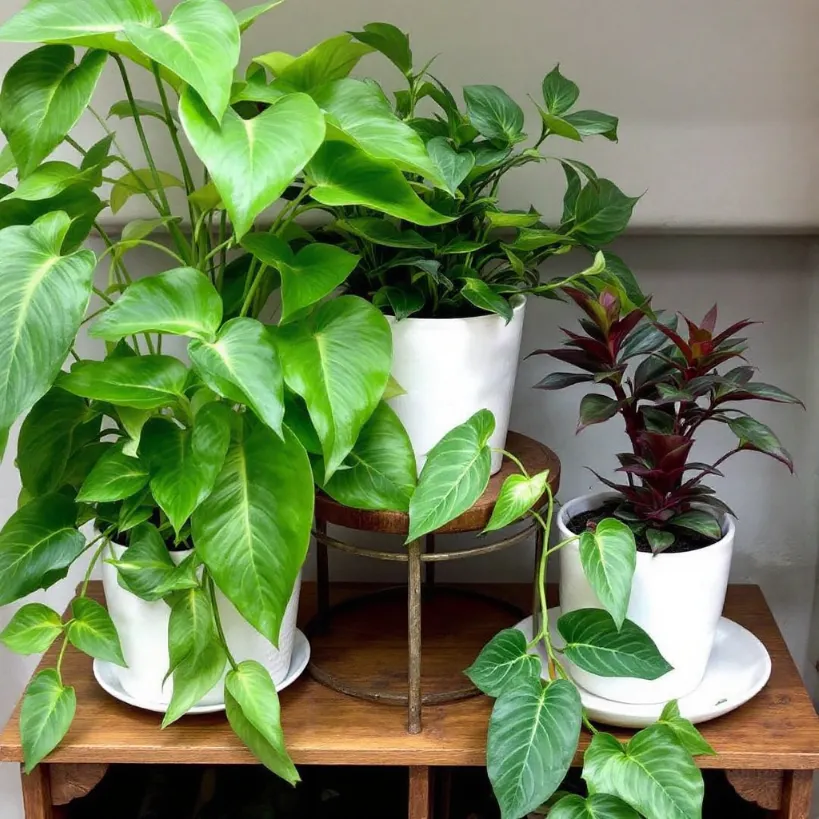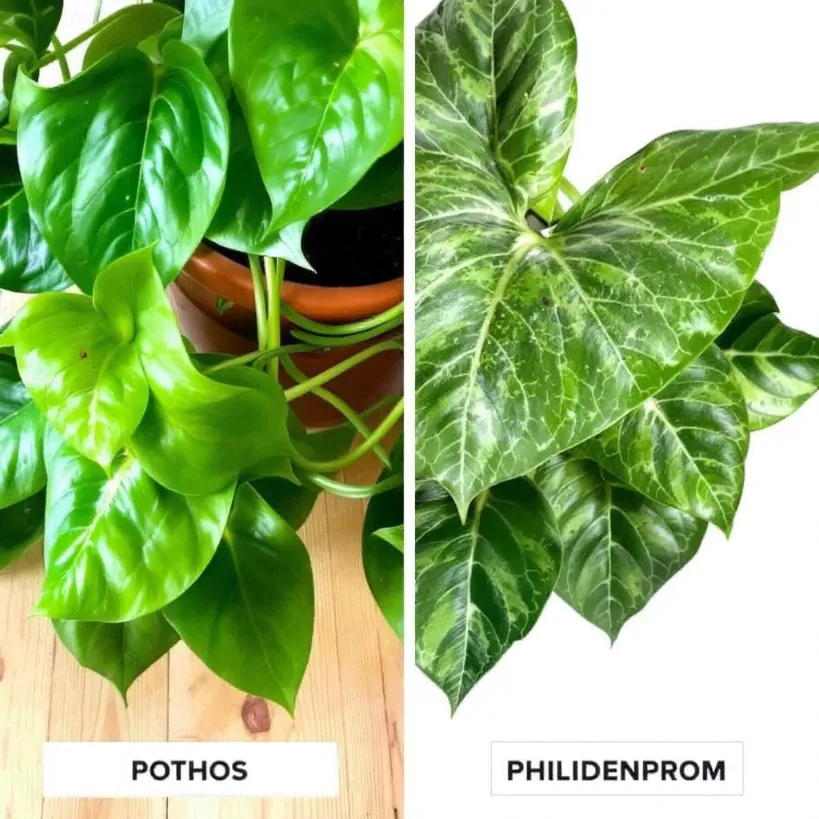Pothos and philodendron plants look damn similar at first glance. Both have heart-shaped leaves, both trail from pots, both survive when you forget them for weeks. But they’re different beasts entirely. The main difference? Pothos leaves are thicker and waxier with straight bases, while philodendron leaves are thinner, heart-shaped, and emerge from protective sheaths called cataphylls. Their petioles (leaf stems) tell another story — pothos have grooved indentations while philodendron stems are smooth and rounded.
These aren’t just semantic differences for plant nerds. Knowing which green friend you’ve adopted affects how you care for it. Pothos can handle more neglect and lower light, while philodendrons need brighter conditions to avoid getting leggy. Both belong to the Araceae family but come from different genera — pothos from Epipremnum and philodendron from, well, Philodendron.

Key Takeaways
- Pothos leaves are thicker and waxier with straighter bases; philodendron leaves are thinner, softer, and more distinctly heart-shaped
- Philodendron new growth emerges from protective cataphylls (sheaths); pothos leaves simply unfurl from previous growth
- Pothos has one thick aerial root per node; philodendrons have multiple thinner aerial roots per node
- Pothos petioles have an indented ridge; philodendron petioles are completely rounded
- Pothos tolerates lower light and less frequent watering than philodendrons
- Both plants are toxic to humans and pets if ingested, causing mouth irritation and potential vomiting
Physical Differences Between Pothos and Philodendron

The differences between these plants aren’t subtle once you know what to look for. They’re like twins raised in different homes — similar genetics, different personalities.
Leaf Shape and Texture
Pothos leaves feel like waxed paper — thick, sturdy, glossy. Philodendron leaves feel delicate, thin, almost papery. Touch them blindfolded and you’d know the difference.
The shape tells another story. Philodendron leaves have that dramatic heart shape with a deep curve where the leaf meets the stem. Pothos leaves look more like a teardrop or “folded pizza slice” with a straighter base. The midrib — that center line running down the leaf — is indented on pothos but smooth on philodendrons.
Growth Patterns and New Leaves
Watch how they grow new leaves and you’ll never confuse them again. Philodendrons are dramatic — new leaves emerge from protective sheaths called cataphylls. These sheaths eventually dry up and fall off, leaving little brown scars on the stem. The new leaves often have a reddish tint before turning green.
Pothos? No drama. New leaves simply unfurl from previous growth, starting pale green and darkening with age. No protective coverings, no color changes — just straightforward growth.
Aerial Roots and Petioles
Both plants send out aerial roots to climb and anchor themselves, but they do it differently. Pothos produces one thick, stubby aerial root per node. Philodendrons send out multiple thin, scrappy aerial roots at each node, giving them a wilder appearance.
The petioles — those little stems connecting leaves to the main vine — are dead giveaways. Pothos petioles have an indented groove running along their length, sometimes brownish in color. Philodendron petioles are completely rounded and smooth, usually green or lighter than the foliage.
Care Differences
These plants aren’t just visually different — they need different care too.
Light Requirements
Both can handle low light, but philodendrons get leggy faster without enough brightness. Pothos will keep its shape longer in dim conditions, though both prefer bright, indirect light for optimal growth.
Pothos thrives near south-facing windows but out of direct sunlight. Philodendrons prefer bright spots too but can handle slightly less intense light.
Watering Needs
Pothos wins the drought-tolerance contest. It can go longer between waterings and bounces back better from neglect. Philodendrons prefer more consistent moisture and will show their displeasure with drooping leaves when thirsty.
For both plants, wait until the top inch or two of soil dries out before watering again, but philodendrons will need that drink sooner than pothos.
Growth Rate and Habits
Both grow quickly during spring and summer, but pothos often puts out new leaves weekly during growing season. Philodendrons grow a bit slower but steadily.
Pothos vines tend to be thicker and can grow longer without losing leaves. They’ll spread farther and wider if given the chance. Philodendrons stay more compact while still trailing beautifully.
Which Plant Is Better For Beginners?
If you kill every plant you touch, get a pothos. They’re the cockroaches of the plant world — nearly indestructible. Forget to water for weeks? Pothos shrugs it off. Low light corner of a basement apartment? Pothos makes do.
Philodendrons aren’t divas, but they need a bit more attention. They’ll forgive you for missing a watering, but not as readily as pothos. They need slightly brighter conditions to avoid getting stretched out and leggy.
Both make excellent starter plants, but pothos edges out philodendron for absolute beginners or the chronically forgetful.
Propagation Methods
Both plants propagate easily in water, but pothos roots faster. Cut a section with at least one node, remove lower leaves, and place in water. Pothos will show roots within days; philodendrons might take a week or two longer.
Once roots reach about an inch long, you can transfer to soil. Keep the soil moist for the first few weeks as your cutting adjusts to its new growing medium.
Common Varieties Worth Knowing
Popular Pothos Varieties
Golden Pothos: The classic with yellow variegation
Marble Queen: Heavily variegated with white and green
Neon Pothos: Bright chartreuse leaves that glow
Jade Pothos: Solid green leaves
Pearls and Jade: Compact with white and gray variegation
Popular Philodendron Varieties
Heartleaf Philodendron: The classic vining type
Brasil Philodendron: Variegated with yellow stripes
Micans Philodendron: Velvety leaves with coppery undersides
Pink Princess: Green leaves with pink variegation
Birkin Philodendron: Green leaves with white pinstripes
Toxicity Concerns
Both plants contain calcium oxalate crystals that are toxic to humans and pets. Ingestion causes irritation to the mouth and digestive tract, potentially leading to vomiting. Keep them away from curious children and pets who might take a taste.
Making Your Final Choice
Choose pothos if:
You’re new to indoor plant basics
You have low light conditions
You often forget to water
You want faster growth
You prefer thicker, waxier leaves
Choose philodendron if:
You can provide brighter light
You’re good with regular watering
You prefer a more compact growth habit
You like thinner, heart-shaped leaves
You enjoy watching the dramatic unfurling of new leaves
Or do what most plant people do — get both. They look great hanging side by side, and their subtle differences become more apparent when you can compare them directly.
References:
https://growfully.com/pothos-vs-philodendron/
https://www.gardenia.net/guide/pothos-vs-philodendron-which-houseplant-is-right-for-you
https://www.masterclass.com/articles/pothos-vs-philodendron
https://www.wellandgood.com/lifestyle/pothos-vs-philodendron
https://cheekyplantco.com.au/blogs/plants-blog/the-differences-between-pothos-and-philodendron
https://plantcareforbeginners.com/articles/pothos-vs-philodendron
https://www.thespruce.com/pothos-vs-philodendron-differences-5069402
Better yet — grow both. These plants have earned their popularity through decades of reliable performance in homes worldwide. Their subtle differences make them perfect companions rather than competitors in any indoor garden.
Related Resources
- This approach is complemented by the strategies outlined in our 10 Best Humid Houseplants That Thrive (2025 Guide) resource 10 Best Humid Houseplants That Thrive (2025 Guide).
- To understand this better, consider reading about How to Build a Terrarium in 5 Easy Steps [2024 Guide] How to Build a Terrarium in 5 Easy Steps [2024 Guide].
- This concept relates closely to what we cover in our analysis of Houseplant Propagation: 7 Proven Steps for Rooting Success Houseplant Propagation: 7 Proven Steps for Rooting Success.